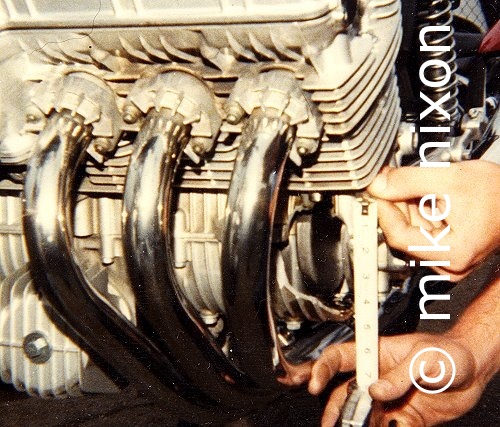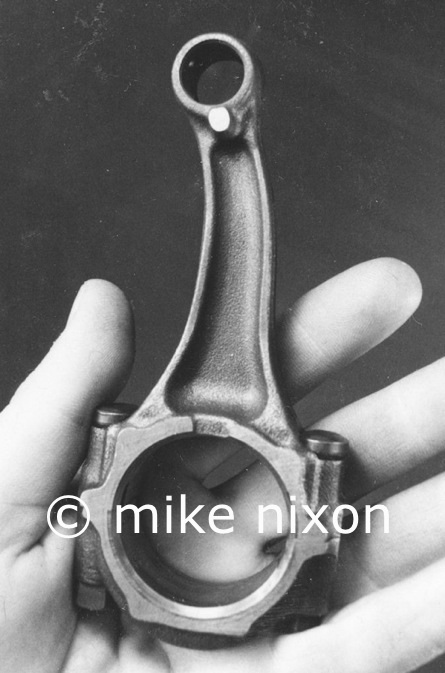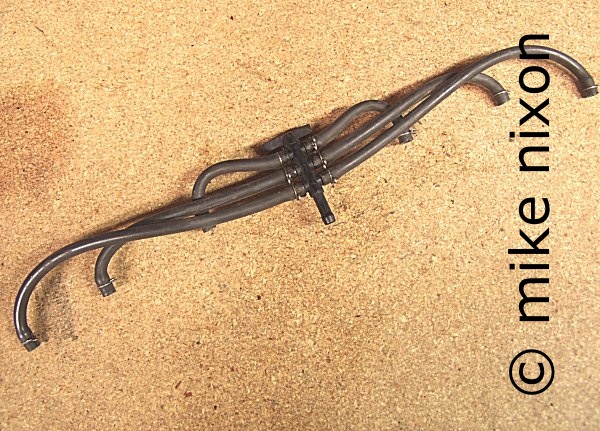  ® ®
|
The "Hole in One" |
|
It was late 1978. I had already attended Honda's 79 model update class, and had prepared for new-bike delivery a few CBXs. Charming bikes, really. Everything the press had to say about the machine was true. It was a masterpiece, and exhibited a til-then unknown level of finesse and fitment from Honda. One day a CBX appeared at the door of the shop, and I was asked to take a look at it. Looked normal, until I spotted the huge hole in the crankcase directly in front of the number one connecting rod. We called in Honda and the L.A. area rep, Fred Germaine, whom I had met before and with whom I had just the previous week worked with at Honda's L.A. training school, appeared and he said something I have never forgotten. He approved the repair and turning, he said to me, "remove the float bowl overflow drain hoses. They're the problem." I clearly remember thinking, "really?" But by then I had come to understand some of the workings of Mother Honda, and later, while working with the corporate office I would understand far more. When the CBX is on the sidestand and one or more of the carburetor's float bowls takes that infrequent but inevitable dump, the escaping fuel that on other machines simply falls to the ground, on the CBX has to take a circuitious route to do so. Because the six hoses are tied together in a Y shape, any little bit that the other carbs might also spit is encouraged by capillary action, and if the rider has left the fuel petcock on this is even more likely, and soon there is a significant fuel load in the overflow system. The bike is on its sidestand, the number six carb is 3-4" higher than the number one carb, everything runs downhill, and the numbers one and two hoses get the load, but especially the number one. The fuel goes into the cylinder, whether the intake valve is open or not (the difference is one only of speed), and soon the number one cylinder is loaded with fuel. This fuel being incompressible and the connecting rods Honda made being fairly lightweight in construction, any attempt to start the machine results in a bent connecting rod. Most folks realized the problem before breaking anything, whether through the extremely slow starting and occasional kickback, or the rough idling and reduced performance. But others did not know anything was wrong until like our customer the rod let go and exited the engine cases.
There was never anything written on this issue, just as there was never any public acknowledgement of the alternator clutch issue. No recall, no service campaign of any kind. But, the following year Honda did two things. One, they fitted the very first vacuum valve to appear on any U.S. model Honda motorcycle. This is significant. While Kawasaki and Yamaha and Suzuki had long been manufacturing bikes having vacuum petcocks, 1980 was the first year Honda did so, and they did it to not only the CBX but also several other models. Honda went further and made available a retro kit for fitting this special valve to 1979 CBX models, though it was a slightly different valve because the 79 models have only one fuel inlet as opposed to the 80-82's two inlets. When you see a vacuum valve ("auto valve," in Honda-speak) that has only one fuel inlet, it is this Hondaline (factory accessory) kit valve. And there was no announcement, no service campaign, not even for this valve. Incidentally, it appears now however that certain non-U.S. distributors, notably Australia and possibly also England, took it upon themselves to fit the kit valve on the final wave of 79 bikes at their warehouses before shipping the bikes to their dealers. In essense then, at least one or two markets got the auto valves as original equipment on the last 79s sold. I have rarely see this valve on U.S. models, though they are out there. However, I often see it on Australian and UK model carbs. Second, Honda revised the float bowl overflow hose system on the 1980 CBX, replacing the 79-spec 6-1 system with the 1980's 6-2 system that would remain through the end of the final, 1982, model. Far from coincidences, these two changes to the CBX speak as loudly as any published bulletin might have, had there been one.
I strongly suggest to my customers they do not reuse the 79 overflow system. That leaves three options. You can fit the 80 through 82 hoses, or you can fit individual hoses, or you can leave off any hoses at all. All are good choices. If you have the auto valve, make sure it works, as they fail after 20+ years. If the manual valve, make sure you shut it off religiously. |


